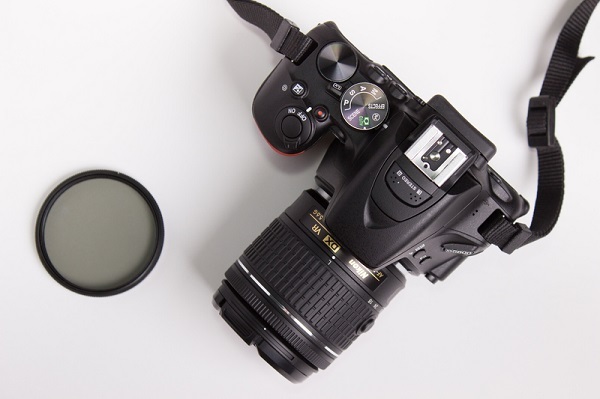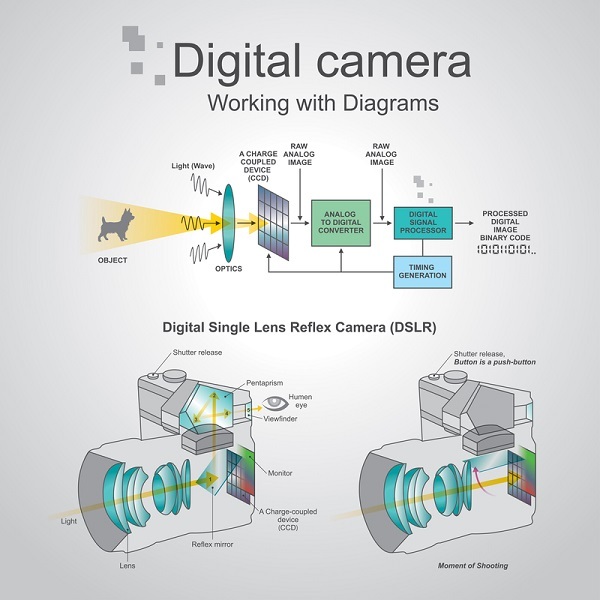
 Data Structure
Data Structure Networking
Networking RDBMS
RDBMS Operating System
Operating System Java
Java MS Excel
MS Excel iOS
iOS HTML
HTML CSS
CSS Android
Android Python
Python C Programming
C Programming C++
C++ C#
C# MongoDB
MongoDB MySQL
MySQL Javascript
Javascript PHP
PHP
- Selected Reading
- UPSC IAS Exams Notes
- Developer's Best Practices
- Questions and Answers
- Effective Resume Writing
- HR Interview Questions
- Computer Glossary
- Who is Who
DSLR: Digital Single Lens Reflex
Introduction
DSLR is the abbreviation for digital single lens reflex, it is a type of camera that uses a reflex mirror and single lens to capture the light onto the sensors. DSLR started becoming popular and eventually replaced the film-based SLRs in the 2000s. DLSRs had many advantages over film-based cameras such as larger storage as you weren't limited to a fixed film size and could store thousands of pictures in the digital format. Learn more about DSLRs in the following article.

DSLR: Full Form and Meaning
The full form of the word DSLR is Digital Single Lens Reflex. It is a type of digital camera that has a digital sensor, one single lens for the main mechanism (which means the lenses for the viewfinder and taking the picture is the same), and a reflex mirror that can change its orientation. The following image shows the inside mechanism of a DSLR camera.
The first consumer-based DSLR camera, FinePix S1 Pro, was introduced by FujiFilm in January 2000, before that, Nikon, Sony, and many others had presented their prototypes and some professional DSLRs. Later in 2008, Nikon released, D90, the first video recording DSLR for consumer use.
Design of DSLRs
DSLRs usually consist of 8 parts,
Interchangeable camera lens
Reflex mirror
Focal plane shutter
Image sensor
Matte focusing screen
Condenser lens
Pentaprism/Pentalens
Eyepiece
At a time either parts 5-8 or 3 and 4, only one group is functioning. Before taking the image, the light comes through the lens and is reflected towards the matte focusing screen, passing through it and the condenser lens and then undergoing total internal reflection in the pentaprism finally passing through the eye-piece. While taking the image the reflex mirror moves out of the way making the lens directly go to the focal plane shutter and then the image sensor.

Features of DSLRs
There are many different features in a DSLR, some of the features of DSLR are listed below
Mode Dial DSLRs and other Digital Cameras usually offer many different modes for better picture quality thus they have a mode dial that helps in changing between different modes.
Dust Reduction System DSLRs have a dust reduction system in their mechanism to prevent dust from entering the chamber. Some companies use a dust cover or a vibratory system attached to the sensor, that vibrates on ultrasonic frequencies to remove dust particles.
Interchangeable Lenses DSLRs have various lens pieces, that are interchangeable, each lens corresponding to a different situation changing the amount of light captured, focus, zoom, etc.
HD video capture Most DSLRs manufacturers have been providing an HD video capture system inbuilt.
Live Preview Modern DSLRs are consisting of an LCD screen, that shows a live preview of the image that shows on the viewfinder (eye-piece).
Sensor Size and Image Quality Different DSLR manufacturers, use sensors of different sizes that also affect the different cameras' image quality. Some of the sensors are, APS-H (used by Canon), APS-C (used by Nikon, Sony, Fuji, etc.), Foveon (used by Sigma), and Four-thirds system (used by Panasonic and Olympus). There are other sensor sizes also available by some of the above-mentioned manufacturers.
Depth of Field Control DSLRs offer control over changing the focal length of the camera using Depth of Field control.
The Angle of View The angle of view of a DSLR image can also be changed using the Depth of field control.
Conclusion
In this article, we learned about DSLRs, their design, and their features. DSLRs are Digital Single Lens Reflex Cameras, i.e., a type of camera that has a single lens viewfinder mechanism using a reflex mirror and digital storage for the images captured. DSLRs have many advantages over film-based SLRs, such as high storage capacity and not having to constantly buy new films since we can erase digitally stored photos and take new ones. DSLRs have many features that regular cameras do not have i.e., a Dust reduction system, live preview, depth of field, and angle of view control giving it the edge over other cameras in a variety of situations.
FAQs
Q1. What is the full frame size of a DSLR, and what are the sensor sizes of APS-H, APS-C, and Four-Thirds sensors?
Ans: The frame size of a DSLR is, 35mm, 36mm ? 28mm, also known as the ?full frame'. The sizes of APS-H and APS-C and Four-Thirds Sensors are smaller than the full frame. The APS-H is of size 28.7mm ? 19mm, APS-C is of size 23.6mm ? 15.7mm, and the four-thirds sensor is 4/3 inches diagonally giving it the name four-thirds, in mm the frame is 17.3mm ? 13mm.
Q2. What is the purpose of a reflex mirror in a DSLR?
Ans: The reflex mirror is used to reflect the light captured by the camera lens to the pentaprism which then reflects it to the viewfinder, thus we do not need a secondary lens for the viewfinder and can accurately see what the image would look like since the lens is same.
Q3. Which company launched the first touchscreen DSLR, and when was it launched?
Ans: Canon was the first company to launch the first touchscreen DSLR, EOS 650D, which was announced in June 2012.

